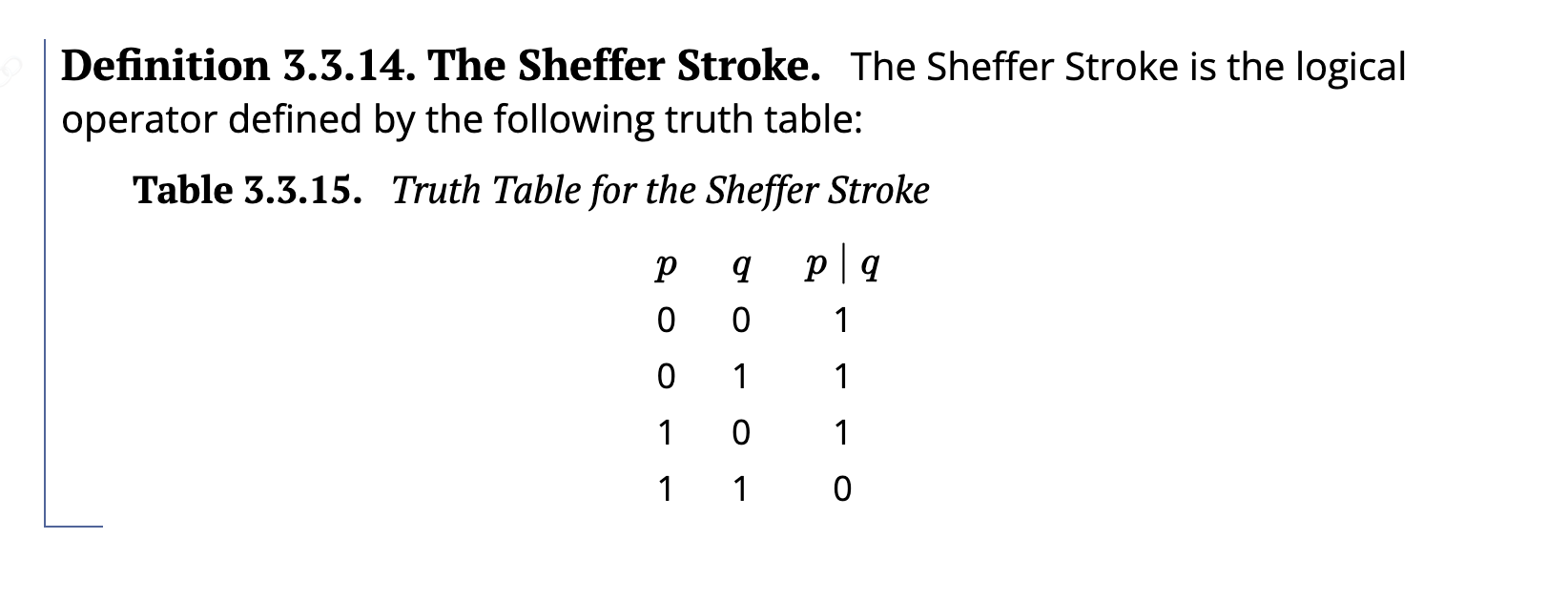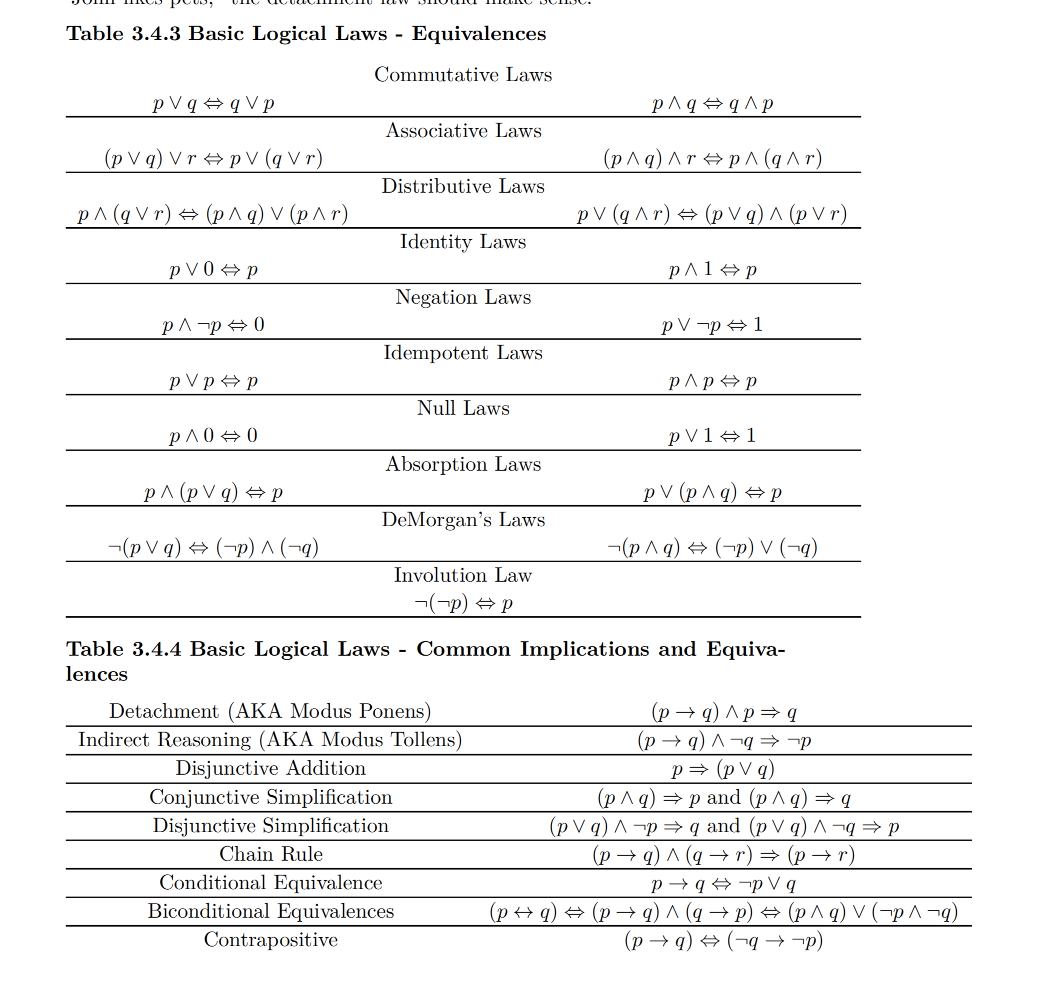5. Introduction to Logic¶
- Proposition: A statement that is either true or false. e.g. “The sky is blue” is a proposition, but “What time is it?” is not.
- Logical Operations:
- Logical Conjunction (AND): \(p \land q\) is true if both \(p\) and \(q\) are true.
- Logical Disjunction (OR): \(p \lor q\) is true if either \(p\) or \(q\) is true.
- Logical Negation (NOT): \(\neg p\) is true if \(p\) is false.
- Conditional Statement (IF-THEN): \(p \to q\) is false if \(p\) is true and \(q\) is false, otherwise it is true. The order
condition => conclusionis important, theq => pis a different statement. - Converse Statement: The converse of \(p \to q\) is \(q \to p\).
- Contrapositive Statement: The contrapositive of \(p \to q\) is \(\neg q \to \neg p\).
- Logical inverse: The inverse of \(p \to q\) is \(\neg p \to \neg q\).
- Biconditional Statement (IF AND ONLY IF): \(p \leftrightarrow q\) is true if \(p\) and \(q\) have the same truth value.
| Operation | Symbol | Comments |
|---|---|---|
| Logical Conjunction (AND) | \(p \land q\) | |
| Logical Disjunction (OR) | \(p \lor q\) | |
| Logical Negation (NOT) | \(\neg p\) | |
| Conditional Statement | \(p \to q\) | false if \(p\) is true and \(q\) is false, otherwise it is true. |
| Converse Statement | \(q \to p\) | |
| Contrapositive Statement | \(\neg q \to \neg p\) | The inverse of the converse |
| Logical inverse | \(\neg p \to \neg q\) | |
| Biconditional Statement | \(p \leftrightarrow q\) | true if \(p\) and \(q\) have the same truth value (either T or F) |
- Number of possible truth value rows for a statement with \(n\) variables: \(2^n\)
- If we have the number of possible rows, then we can find the number of variables: \(\log_2(n)\)
Equivalence and Implication¶
- Equivalence: Two statements are equivalent if they have the same truth table, they must be a tautology and is denoted by \(p \ q\) . That is, they have the same truth value for each possible combination of truth values of their variables.
- Tautology: A statement that is always true, regardless of the truth values of its variables. E.g. \(p \lor \neg p\) is always true. All tautologies are equivalent.
- Contradiction: A statement that is always false, regardless of the truth values of its variables. E.g. \(p \land \neg p\) is always false. All contradictions are equivalent.
- Implication:
- \(p \implies q\) is true when \(p \rightarrow q\) is a tautology.
- \(p \implies q\) is equivalent to \(\neg p \lor q\).

The laws of logic¶
Mathematical Systems and Proofs¶
- Mathematical System: A collection of related:
- A universe: a set of objects
- Definitions: statements that describe the objects in the universe.
- Axioms: assertions about the rules of the system.
- Theorems: additional assertions that can be proved using the axioms and definitions.
- Euclidean geometry: Is a system, where the universe is a set of points and lines. Definitions include the definition of parallel lines. Axioms include that two parallel lines never intersect. Theorems include that the sum of the angles of a triangle is 180 degrees…etc.
- Theorem:
- It is a true proposition derived from the axioms and definitions of a mathematical system.
- Theorems start with premises (set of propositions) and end with a conclusion (one true proposition).
- The premises imply the conclusion.
- The previously proved theorems can be used as axioms to prove new theorems (assumed to be true).
- Axioms are assumed to be true without proof.
- The newly proved theorems can be used to prove other theorems.
- Proof
- is a sequence of logically valid steps that demonstrate that the premises imply the conclusion.
- Characteristics:
- Must end in a finite number of steps.
- Each step is either a premise, or a proposition that is driven from previous steps using equivalence or implication.
- For direct proofs, the last step must be the conclusion.
- For indirect proofs, the last step must be a contradiction.
- Justification comments are added to each step to explain why it is valid.
- Direct Proof: A proof that starts with the premises and uses logical steps to arrive at the conclusion.
- Indirect Proof: A proof that starts with the premises and uses logical steps to arrive at a contradiction. The contradiction proves that the conclusion is true.
Quantifiers¶
- If \(p(n)\) is a proposition over a universe U, its truth set \(T_p\) is equal to a subset of \(U\).
- In many cases, such as when \(p(n)\) is an equation, we are most concerned with whether \(T_p\) is empty or not.
- In other cases, we might be interested in whether \(T_p = U\); that is, whether \(p(n)\) is a tautology.
- Since the conditions \(T_p = ∅\) and \(T_p = U\) are so often an issue, we have a special system of notation for them.
- Existential Quantifier: (reads there exist) \(\exists n \in U, p(n)\) is true if \(T_p \neq ∅\). That is, if the truth set is not empty, then there exists at least one element in the universe that makes \(p(n)\) true.
- Universal Quantifier: (reads for all) \(\forall n \in U, p(n)\) is true if \(T_p = U\). That is, if the truth set is the entire universe, then \(p(n)\) is true for all elements in the universe.
References¶
- Doerr, A., & Levasseur, K. (2022). Applied discrete structures (3rd ed.). licensed under CC BY-NC-SA. https://discretemath.org/ads/chapter_7.html.
- Levin, O. (2021). Discrete mathematics: An open introduction (3rd ed.). licensed under CC 4.0.
